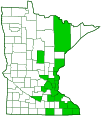Ruby Bolete
(Hortiboletus rubellus)
Conservation • Description • Habitat • Ecology • Distribution • Taxonomy
|
|
||||||||||||||
Description |
Ruby Bolete is a small, red capped, blue staining mushroom. It occurs in Europe, in the United States east of the Great Plains and west of the Rocky Mountains, in southern Quebec and Ontario Canada, and in Mexico. It reaches the western extent of one part of its range in eastern Minnesota. It is found in summer and fall in deciduous woodlands, at woodland edges, in parks, and in gardens. It grows on the ground, alone, scattered, or in groups (gregarious) but not clustered. It has a mutually beneficial relationship (mycorrhizal) with the tiny rootlets of oaks and other hardwood trees, absorbing sugars and amino acids while helping the tree absorb water. The cap is 1″ to 2⅜″ (2.5 to 6.0 cm) in diameter. It is convex at first and bright but dark pinkish-red. This is the feature that gives the mushroom its common name. It often has a thin yellow or whitish band around the margin. The upper surface is dry and is covered with minute velvety hairs. As it ages it becomes broadly convex to almost flat and hairless, and the color becomes dark, dirty, pinkish-red or pinkish. On mature specimens the upper surface is finely cracked. The stalk is firm, solid, 13⁄16″ to 2¾″ (3 to 7 cm) long, longer than the cap is wide, and ⅛″ to ⅜″ (4 to 10 mm) thick. It is tapered at the base and sometimes flared at the top. The surface is not covered with a network of fine ridges (reticulate). When young the stalk is pinkish to red for most of its length, yellow just near the top, and the surface usually has numerous fine red dots (punctate). It darkens as it ages. The pore surface is yellow when young, becoming dull olive-yellow as it ages. It quickly stains dark blue when bruised. There are 1 to 3 pores per millimeter. The pore tubes are up to ¼″ (7 mm) deep. The flesh in the cap is whitish. It slowly stains slightly blue when sliced. It is edible but it has a soapy taste, and like other boletes, it is often infested with maggots. The flesh of the stalk is mostly yellow, pale yellow just at the top. It has numerous, tiny, bright red or carrot orange dots near the base. This may require a hand lens to see and is visible only on young specimens. On older specimens the flesh at the base deteriorates and discolors. The spore print is olive-brown. |
Similar Species |
Habitat and Hosts |
Deciduous woodlands, woodland edges, parks, and gardens Oaks and other hardwoods |
Ecology |
Season |
Summer and fall |
Distribution |
||
|
Sources Biodiversity occurrence data published by: Minnesota Biodiversity Atlas (accessed through the Minnesota Biodiversity Atlas Portal, bellatlas.umn.edu, 7/15/2025). |
|
| 7/15/2025 | ||
Occurrence |
||
|
||
Taxonomy |
|
Kingdom |
Fungi (fungi) |
Subkingdom |
Dikarya |
Phylum |
Basidiomycota (club fungi) |
Subphylum |
Agaricomycotina (jelly fungi, yeasts, and mushrooms) |
Class |
Agaricomycetes (mushrooms, bracket fungi, puffballs, and allies) |
Subclass |
Agaricomycetidae |
Order |
Boletales (boletes and allies) |
Suborder |
Boletineae |
Family |
|
Genus |
Hortiboletus |
Subordinate Taxa |
|
|
|
Synonyms |
|
Boletus caribaeus Boletus caribaeus var. crassotunicatus Boletus chrysenteron var. versicolor Boletus fraternus Boletus rubellus Boletus rubellus ssp. bicoloroides Boletus rubellus ssp. borneensis Boletus rubellus ssp. caribaeus Boletus rubellus ssp. consobrinus Boletus rubellus ssp. dumetorum Boletus rubellus ssp. fraternus Boletus rubellus ssp. purpureus Boletus rubellus ssp. rubeus Boletus rubellus var. flammeus Boletus rubeus Boletus sanguineus Boletus subtomentosus var. rubellus Boletus versicolor Ixocomus sanguineus Leucobolites rubellus Suillus rubellus Suillus rubeus Suillus sanguineus Suillus versicolor Tubiporus rubellus Versipellis pruinata var. versicolor Versipellis versicolor Viscipellis sanguinea Xerocomellus rubellus Xerocomus chrysenteron var. versicolor Xerocomus rubellus Xerocomus versicolor |
|
Common Names |
|
Ruby Bolete |
|
Glossary
Mycorrhizal
A symbiotic, usually beneficial relationship between a fungus and the tiny rootlets of a plant, usually a tree.
Visitor Photos |
||
Share your photo of this fungus. |
||
This button not working for you? |
||
Damian and Dacia Lowe |
 |
Andrea Zimmerman |
||
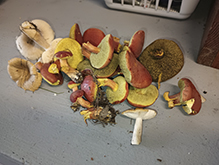 |
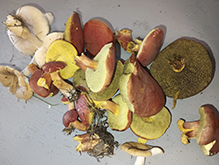 |
|
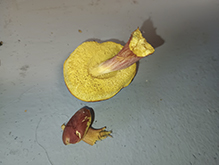 |
||
Holly Stanger |
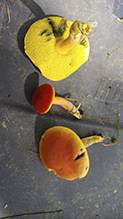 |
found by our chicken coop |
MinnesotaSeasons.com Photos |
||

Slideshows |
|

Visitor Videos |
||
Share your video of this fungus. |
||
This button not working for you? |
||
|
Other Videos |
||
Hortiboletus rubellus (Ruby Bolete) 4k |
About
Aug 2, 2020 Hortiboletus rubellus By Manu Merino Today I present an incredible species. It is now called Hortiboletus rubellus but it is also known as Xerocomus Rubellus. I have found the specimens of this video, in the best moment of their life, that's why those garnet colors are so impressive. I also share a bit of the nature of the environment, such as the most popular and beautiful European butterfly, the Papilio machaon and two plants, the Sedum album and the stachys officinalis. And if you liked the Santa Catalina lighthouse - Lekeitio, last week, I can assure you, that the sunset from this place is the most spectacular in the entire Basque Country.
Hortiboletus rubellus (Krombh.) Simonini, Vizzini & Gelardi - (2015) Characteristics: Confusions: It is not easy to identify this species, therefore it can be confused with Xerocomellus chrysenteron less reddish, with Rheubarbariboletus armeniacus in apricot color Music: Back_To_Vik and Dream_Lagoon from the You tube Thanks to Enrique Expuru for identifying plants I hope you liked the video of this species, and for that I thank you for the visit and the support of the channel. Regards and until next time |
Hortiboletus rubellus (Моховик красный), July 1, 2021 |
About
Jul 7, 2021 Моховик красный, 1 июля 2021 года |
Crveni baršunovac - Hortiboletus rubellus |
About
Nikola Lačković |

Visitor Sightings |
||
Report a sighting of this fungus. |
||
This button not working for you? |
||
| Andrea Zimmerman 7/1/2023 |
Location: Klickitat St, Big Lake, MN 55309 |
| Holly Stanger 8/19/2022 |
Location: Freeborn County found by our chicken coop |
MinnesotaSeasons.com Sightings |
||
|

Created: 8/30/2022 Last Updated: © MinnesotaSeasons.com. All rights reserved. |
